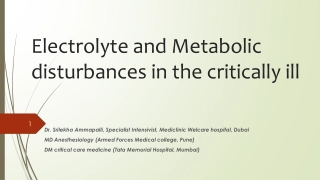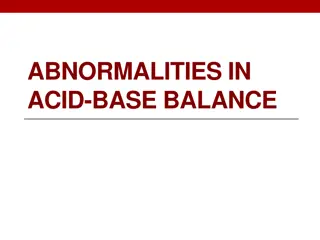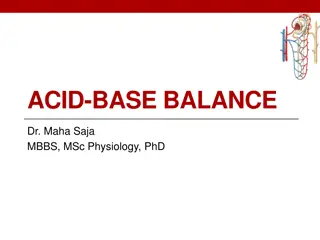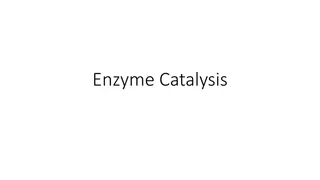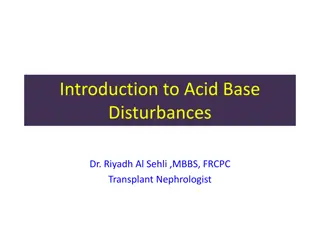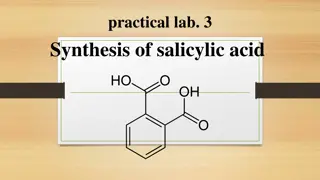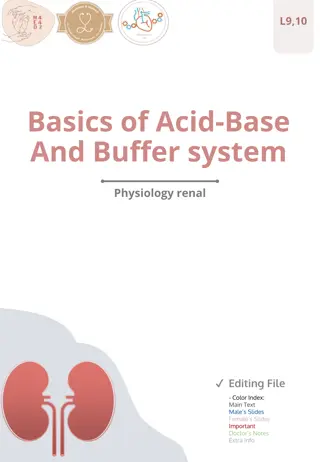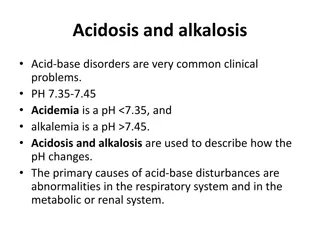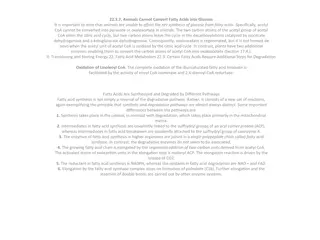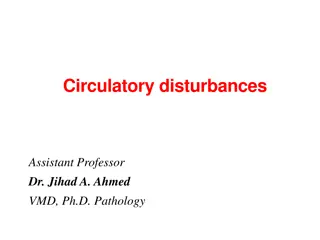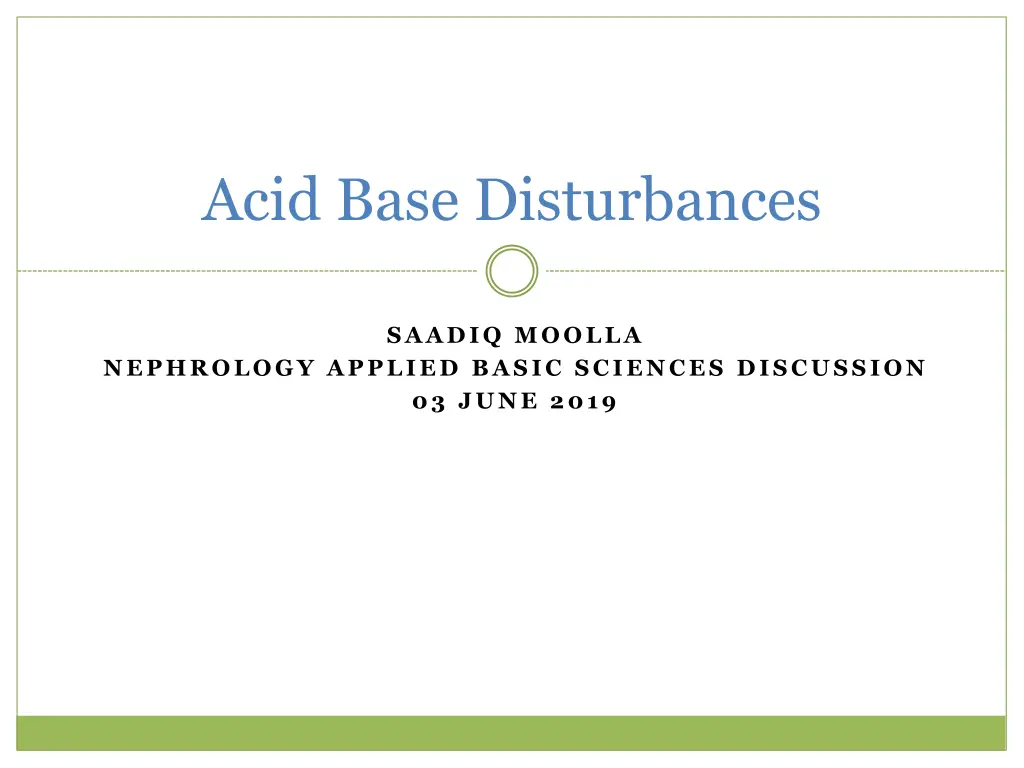
Acid-Base Disturbances and Renal Acid-Base Handling
Explore the intricacies of acid-base disturbances and renal acid-base handling in the body, including plasma pH regulation, sources of acid and alkali, the bicarbonate buffer system, assessment of acid-base disturbances, anion gap calculation, and NH4+ excretion. Gain insights into maintaining the body's delicate pH balance for optimal health.
Uploaded on | 1 Views
Download Presentation

Please find below an Image/Link to download the presentation.
The content on the website is provided AS IS for your information and personal use only. It may not be sold, licensed, or shared on other websites without obtaining consent from the author. If you encounter any issues during the download, it is possible that the publisher has removed the file from their server.
You are allowed to download the files provided on this website for personal or commercial use, subject to the condition that they are used lawfully. All files are the property of their respective owners.
The content on the website is provided AS IS for your information and personal use only. It may not be sold, licensed, or shared on other websites without obtaining consent from the author.
E N D
Presentation Transcript
Acid Base Disturbances SAADIQ MOOLLA NEPHROLOGY APPLIED BASIC SCIENCES DISCUSSION 03 JUNE 2019
Plasma pH A measure of free [H+] in body fluids Normally 40 2 nmol/L pH = - log [H+] = - log (0.00000004) = 7.4 Tightly controlled to decrease H+binding to proteins which can interfere with protein function
Sources of Acid and Alkali Normal metabolism produces 40 80 mmol of H+ Oxidation of S-containing amino acids Carbohydrates Usually ATP + CO2+ H2O CO2converted to acid H2CO3 Abnormally lactic acid and ketoacids Dietary alkalis like citrate and malate metabolised in liver to HCO3-
Bicarbonate Buffer System Main buffer system in the body H++ HCO3- H2CO3 H2O + CO2 HCO3-binds and removes H+, maintaining pH Removal of CO2in the lungs drives reaction to right H+ Poor circulation High PCO2 CO2 CO2 HCO3-
Renal Acid Base Handling In the lumen H+ buffered by NH3 Forms NH4+ N: 30 40 mmol/d : 200 mmol/d HCO3- absorbed Carbonic anhydrase Prevents wasting H+ excreted Intercalated cells H+ ATPase Excretes acid Adds HCO3- In alkalosis absorption of anions Restores balance Prevents HCO3- loss Urine not alkalotic
Assessment of Acid Base Disturbance Assess and treat immediate threats to life Assess ECF status Assess components of bicarbonate buffer system pH ([H+]) N: 7.35 7.46 [HCO3-] N: 22 26 mmol/L metabolic component PCO2 N: 4.5 6.1 kPa respiratory component Metabolic Respiratory Acidosis pH HCO3-( CO2) pH CO2( HCO3- ) Alkalosis pH CO2( HCO3- ) pH HCO3-( CO2)
Anion Gap Positive and negative charges in body balanced For every cation there must be an anion AG = [Na+] ([Cl-] + [HCO3-]) Gap due to unmeasured anions: plasma proteins esp. albumin N: 12 2 mEd/L AG suggests addition of unmeasured anion
NH4+ Excretion Urine pH reflects [free H+] Max = 0.1 mmol/L = pH 4.0 Most acid excreted as NH4+ Not measured at lab Must be calculated NH4+ = (U-Osm [Urea]) ([Na+] + [K+])
NH4+ Excretion [] 97 27.4 100 NH4+ = ? Na+ K+ Cl- Anions = ? K+ = 27.4 NH4+ = (U-Osm [Urea]) ([Na+] + [K+]) Urea 69 Creatinine 3700 Osmolality 331 Na+ = 97 Urea = 69 331 6.6 262 131
Osmolal Gap Difference of measured & calculated osmolality Calculated osmolality = 2 x ([Na+] + [K+]) + Urea + Glucose N: < 10 mosmol/kg Large gap implies presence of unusual osmoles: Methanol Ethanol Ethylene Glycol
Fractional Excretion of HCO3- Proportion filtered at glomerulus that reaches urine FEHCO3- (%) = [UHCO3- / PHCO3-] / [UCreat / PCreat] x 100 Prox RTA: FEHCO3- > 15% (when plasma HCO3- normal)
Metabolic Acidosis H+ gain AG: new anions derived from the added acid HCO3-: consumed buffering the acid NaHCO3 loss Normal AG HCO3-: lost in GIT or kidneys Cl-
Metabolic Acidosis Metabolic Acidosis AG NAG M methanol U uraemia D DKA P paraldehyde I infection L lactic acidosis E ethylene glycol S salicylates UNH4 UNH4 GIT loss NH4Cl ingestion NGFR GFR Proximal RTA FEHCO3- > 15% Distal RTA H+ excretion U pH > 6.5 NH4+ availability U pH < 5.3 Renal failure
Metabolic Alkalosis in [HCO3-] in ECF Usually deficit of NaCl, KCl, HCl Less frequent gain of NaHCO3 Alkali load renal excretion
Metabolic Alkalosis Metabolic Alkalosis UCl NUCl Vomiting Nasogastric suction Previous diuretic use Vol Vol Hyperaldosteronism Cortisol Overactive ENaC Alkali load Reduced excretion Current diuretic use Diuretic-like disease
Vomiting H+ CO2 + H2O HCO3- H2SO4 Cl- Cl- 2H+ SO42- 2H+ 2K+ 2K+ SO42-
Respiratory Acid Base Disturbances Bicarbonate Buffer System Main buffer system in the body H+ + HCO3- H2CO3 H2O + CO2 HCO3- binds and removes H+, maintaining pH Removal of CO2 in the lungs drives reaction to right H+HCO3- Hb- Cl- H+ CO2 CO2 H2CO3 HCO3- CO2 H2O
Respiratory Acidosis in PCO2 ventilation and expiration of CO2 eg. airway obstruction, resp centre depression, neuromuscular disease If problem persists, renal compensation occurs over 2 4 days with excretion of H+ and retention of HCO3- HCO3- points to chronicity
Respiratory Alkalosis in PCO2 ventilation and expiration of CO2 eg. respiratory centre stimulation, anxiety, hypoxia If problem persists, renal compensation occurs over 1 3 days with retention of H+ and fall of HCO3

